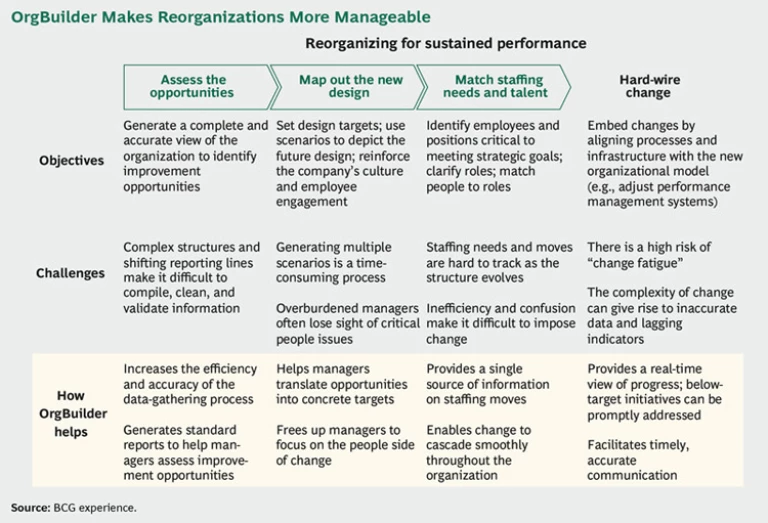Reorganizations play a pivotal role in the business world—few other initiatives have as much potential to reinvigorate a company’s strategy and strengths. They help make companies more effective and efficient by finding and fixing redundancies, suboptimal structures, and misalignments between strategies and designs. And in industries where change is constant and unpredictable, reorganizations play a critical role in allowing companies to continuously adapt to the shifting landscape. As elemental as they are, however, reorganizations are notoriously difficult to implement.
Recognizing the opportunity for technology to address this challenge, BCG developed a software tool, OrgBuilder , that helps companies gather and analyze the data they need to make critical decisions when developing and implementing a new structure. The tool does not make reorganizations painless, but—in the hands of a joint client and BCG team that knows the ins and outs of reorganization—it does bring greater transparency, accuracy, and efficiency to an unwieldy process. More important, it frees up business leaders to spend more time on the issues that matter most, including managing talent, keeping the reorganization locked onto strategic goals, pressing ahead with existing business priorities, and maintaining employee engagement. OrgBuilder also allows companies to keep close tabs on the transformation, tracking every position and person until the reorganization is complete.
OrgBuilder addresses problems that seem endemic to reorganizations. Even the most well-coordinated transformations impose heavy burdens on a company’s senior and middle managers, who—apart from trying to guide a massive change program, stay focused on strategic goals, and keep the business humming—often end up devoting a disproportionate amount of time to gathering, validating, and managing the vast amounts of data needed to make informed decisions about the new structure. Given its functionality and tight fit within the change process, OrgBuilder has become an indispensable part of BCG’s broader approach to reorganizing for sustained performance.
Reorganizing for Sustained Performance
Our approach to reorganization begins with a comprehensive diagnosis of the organization, followed by a high-level view of the redesign. The changes necessary to implement the new design are then cascaded throughout the organization, affording managers at all levels a clear, real-time view of—and responsibility for—how the transformation is unfolding. BCG’s software tool brings order and clarity to each of the following three steps. (See the exhibit below.)
Assess the opportunities. A successful reorganization starts with a comprehensive HR balance sheet—an accurate database of a company’s people and roles, along with such detailed information as each individual’s title, compensation, tenure, and division. To generate this view, the team that’s leading the effort works with HR and business leaders to compile, clean, and validate information, ensuring that all the company’s people and roles are captured. This undertaking can be daunting, given the labyrinthine structure and dynamic nature of many companies. OrgBuilder can make the process far more efficient, accurate, and timely.
This fact-based view of the organization is then used to identify opportunities for improvement, which are typically related to efficiency and effectiveness. Common signs of inefficiency include duplicative roles and responsibilities and substandard performance relative to peers, as measured by benchmarks for specific functions. Inefficiencies often arise from excess layers between the CEO and frontline employees, which slow communication and stall decision making, and from narrow spans of control (managers with a small number of direct reports), which can inhibit empowered, ambitious leadership. OrgBuilder can quickly generate charts and graphs that help managers visualize many of these inefficiencies.
Problems with effectiveness can impede the company’s strategy or blunt its competitive edge. If a company’s success is predicated on its entrepreneurial culture, do local offices have enough autonomy? If it relies heavily on first-to-market innovation, does the organization support risk taking or cross-functional collaboration? Is decision making slowed by unclear decision rights or meetings that always seem to involve too many people? More broadly, companies should ensure that their organizations are structured to enhance performance—for example, by developing centers of excellence that promote best-in-class capabilities or by striking the right balance between decentralized and centralized activities, depending on how and where certain functions come into play.
By highlighting opportunities to improve the business, this first step provides a glimpse of what the target organization might look like. It also sets out a clear rationale for the difficult changes that lie ahead.
Map out the new design. In this step, the company translates the opportunities for improvement into a blueprint for the new organization. It comprises three discrete activities.
- Set targets. Target setting provides guidelines for key aspects of the design—including structure, incentives, and performance management systems—and ensures that the new organization is aligned with the company’s objectives. It is both an art and a science. The targets should be driven by data and analysis, but they ultimately need to be embraced by key stakeholders—they will mean little without adequate buy-in. Once set, the targets are disseminated to senior leaders, who communicate them to their respective parts of the organization and set in motion the initial wave of change.
- Use scenarios to describe the future state. The targets influence the shape of the organization, but senior leaders still have an opportunity to develop and test different permutations of the structure in order to determine which will best fulfill their particular objectives. OrgBuilder is particularly helpful in this phase. It allows the company to understand how variations in the contours of the organization lead to different outcomes. What are the savings implications of melding division A and division B? Would collaboration be enhanced by redefining the reporting lines in division C and division D?
- Reinforce the company’s culture and drive employee engagement. Companies must not lose sight of the design’s impact on culture and employee engagement. Culture describes how things are done in a company. It goes hand in hand with a company’s strategy and sources of advantage. If a company thrives on being an innovator, for example, its culture needs to reflect certain values, like cross-functional collaboration. Engagement, measured by employees’ willingness to go the extra mile for the company, often wanes during reorganizations but is critical in order for change to take hold. With this in mind, the organization needs to reinforce the behaviors, structures, and processes that facilitate the desired culture and engagement level. Above all, the elements that are crucial to engagement must not be subsumed by the company’s push to extract more efficiencies or rationalize its structure.
At the end of this step, the company will have arrived, through a combination of analysis and iteration, at an agreed blueprint for the new structure—one that reinforces its strategy, strengths, and culture and that preserves, to the extent possible, employee engagement.
Match staffing needs and talent. Once the basic shape of the organization has been determined, the company should identify the employees and positions that are most critical to its strategic objectives. This includes top performers, along with the people who are indispensable to a specific strategic initiative or who have specialized knowledge or skills.
Next, the focus shifts to defining—at a high level—key role charters. Role charters clarify accountabilities and decision rights and establish both behavioral expectations and metrics to ensure success for the team and for individuals. These are not your standard job descriptions but rather live documents that clearly link each individual’s responsibilities to the organization’s overall strategy—they change when the strategy changes. They describe roles as they should be, including the collaboration required among them. Defining them early in the transformation—albeit at a high level—is critical to ensuring that the preferred structure will work. For example, at a financial services client, a senior-executive workshop on role charters helped resolve longstanding differences between the corporate head of marketing and the marketing head of a business unit.
It’s then time to start matching people to roles. The most important part of this process is to ensure that individual capabilities are matched to role requirements. OrgBuilder can help companies manage the complexity and breadth of this task. The tool can quickly provide an organizationwide view of the capabilities required for each role and help match people’s skills to current and future needs. Once people are in their roles, they can flesh out the details of their own role charters. But the work does not end yet. To help people in new roles get up to speed quickly, companies should develop a robust onboarding process.
By providing a database that is both comprehensive and current, OrgBuilder brings two critical qualities to this stage of the reorganization:
- It provides a single source of truth. As staffing needs are assessed and addressed, the database is updated to reflect these changes. Transparency helps eliminate much of the inefficiency and confusion that typically bedevil reorganizations. Functioning as a centralized clearinghouse for organizational changes, for example, OrgBuilder makes it easier to redeploy people. A unit that has an excess of top talent can coordinate with a complementary group that has unfilled roles.
- It enables change to cascade throughout the organization. For a reorganization to take root, it should be implemented through a staggered, layer-by-layer approach. Layer 2 should define the changes for layer 3, layer 3 should define the changes for layer 4, and so on. This ensures that changes are understood and, more important, “owned” by each layer before they are passed down to the next. The process of cascading change—a decisive factor in the success of corporate change programs in general—gives managers at each layer some latitude over implementation, although the overarching targets themselves do not change. It is one of the most critical features of BCG’s approach to reorganization.
Hard-Wiring Change
Throughout this process, there needs to be a dedicated focus on embedding change. In addition to having the right leadership in place to drive change and maintain the cadence of day-to-day operations, companies need to communicate the purpose and progress of the transformation early on, particularly among opinion leaders, people at risk of leaving, people who have critical skills, and people in positions that may be altered or eliminated.
As personal as it is, communication, too, can benefit from the use of a software tool. By providing a real-time view of the transformation while linking actions to a broader strategic framework, OrgBuilder can help alleviate some of the anxiety associated with restructuring, which often stems from the confusion and the sometimes inscrutable logic surrounding key decisions. At a more practical level, the software can track which individuals—including top performers or people at risk of leaving—have received certain communications.
A communications strategy should be part of a broader transition plan that hews to the tenets of both change and program management. Companies should define single points of accountability, for example, along with performance management metrics for those individuals responsible for meeting design targets. Individual initiatives should be supported by clearly defined implementation plans, which should be rigorously tested before kickoff. In addition, companies must take a forward-looking view of their progress against important milestones, so they can identify initiatives that are at risk of falling behind schedule and take corrective action before important deliverables are compromised. Ultimately, the enterprise needs to know whether it has accomplished what it set out to do. Has the company become more efficient or effective? Is the organization more closely aligned with its core objectives and capabilities? Does the new organization reflect the company’s culture?
Reorganizations are rarely loved, but they are valued for the results they produce. Moreover, the ability to adapt is fast becoming a strength in and of itself. As the drivers of success in various industries continue to change—owing to a host of factors, including globalization, deregulation, digitalization, connectivity, deconstruction, and the shift from products to services—advantage will inevitably accrue to companies that have the foresight and skills to keep their organizations aligned with their objectives.
















